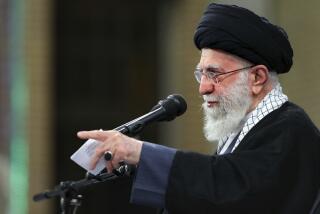A Grave Confluence
- Share via
The eerie green nightscope images broadcast by CNN from Baghdad Wednesday night, vividly recalling the onset of the Persian Gulf air war eight years ago, brought the world its first news that a large-scale punitive attack on Iraq was underway. Not long afterward, President Clinton presented a strong justification for the attack, based on Iraq’s past deceptions and aggression and a reasonable fear of what, left unhindered, Saddam Hussein’s regime might do in the future.
The strike by U.S. cruise missiles and airplanes had been anticipated and in fact had been made virtually inevitable. To no one’s surprise, Iraq’s promise last month to cooperate fully with U.N. weapons inspectors promptly proved to be as untruthful as all the similar assurances that preceded it. As chief inspector Richard Butler reported to the United Nations this week, Iraq not only failed to cooperate in the inspection process over the past month but “initiated new forms of restrictions” to impede the search for documents and materials used in its outlawed weapons programs. In November, after Hussein’s last-minute promise of compliance canceled a planned cruise missile attack, American and British officials indicated that Iraq’s next provocation would not go unpunished. That provocation came in the last two weeks.
This time no lengthy buildup of American military power was needed, no prolonged search for an international consensus was felt necessary or undertaken. Immediately after submitting his report on Baghdad’s noncompliance, Butler ordered his inspectors to leave Iraq. The International Atomic Energy Agency, which monitors Iraq’s nuclear program, also swiftly moved its people out of harm’s way. The U.S. forces earlier deployed in the Persian Gulf area have remained largely in place and in some respects are stronger today than they were a month ago. In addition to its carrier planes the naval force packs 300 Tomahawk cruise missiles.
Fifteen B-52 bombers, each able to carry 20 cruise missiles armed with 2,000-pound warheads, stand ready at Britain’s Diego Garcia base in the Indian Ocean. More than a score of British bombers have joined with the United States in the operation dubbed Desert Fox, and additional U.S. forces are on the way.
Why did Iraq choose to force a confrontation so quickly? Hussein, a habitual miscalculator in international relations, may have believed that the impeachment drama in Washington had left Clinton so paralyzed politically that he would be unable to act. Or he may have assumed that Iraq would be immune from attack during the Muslim holy month of Ramadan, which begins this weekend. What he did not take into account was the three-or-four-day window of opportunity for military action preceding the onset of Ramadan.
The hard truth, whatever the shoot-from-the-lip suspicions of some of Clinton’s pro-impeachment critics, is that Washington and London were left with only one credible course of action. Iraq had refused to provide U.N. inspectors with documents known to detail the extent of its clandestine weapons programs, and it had barred inspectors from sites where prohibited materials may be hidden. That, we think it’s clear, more than anything else controlled the timing of the attack that American and British officials have repeatedly warned could come.
More than seven years ago Iraq was ordered by the Security Council to provide immediate and unconditional access to all information and materials related to its programs to produce weapons of mass destruction. Its repeated evasions and defiance of that order not only invited but compelled the powerful military response that is now underway.
More to Read
Sign up for Essential California
The most important California stories and recommendations in your inbox every morning.
You may occasionally receive promotional content from the Los Angeles Times.













